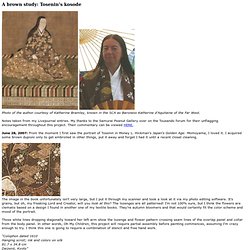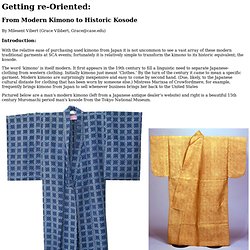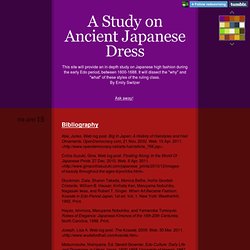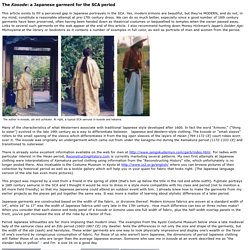

手描き京友禅の作り方-how to make Kimono (熨斗 - 引き振袖) 有限会社 琢磨. Kujō (nine horizontal cloths) robe with gold-leaf arabesque pattern on purple-red base - eKokuhou. Mboogiedown's Photostream. TOKYO NATIONAL MUSEUM - Collections The TNM Collection Object List Kosode dress. Design of flowering plants of autumn on white ground. Welcome to the Elegant World of the Heian Period. Sengoku Daimyo homepage. "Kyoto Kimono: Inspired Grace and Elegance from Momoyama to Edo"
A brown study. A brown study: Tosenin’s kosode Photo of the author courtesy of Katherine Bramley, known in the SCA as Baroness Katherine d'Aquitaine of the Far West.

Notes taken from my Livejournal entries. My thanks to the Samurai Peanut Gallery over on the Tousando forum for their unflagging encouragement throughout this project. Their commentary can be viewed HERE. June 28, 2007: From the moment I first saw the portrait of Tosenin in Money L. The image in the book unfortunately isn't very large, but I put it through my scanner and took a look at it via my photo editing software. Those white lines dropping diagonally toward her left arm show the lozenge and flower pattern crossing seam lines of the overlap panel and collar from the body panel. "Colophon dated 1610 Hanging scroll; ink and colors on silk 81.7 x 34.8 cm Daizenji, Kyoto” ".....The dark colors and small, complex patterns of her garments exemplify the luxurious textiles current in the Keicho era (1596-1615).
(That was crap. Noma, Seiroku. Close Friends. This is the home page of Lisa Jo. Samurai Eye For The SCA Guy A Gallery of Your Photos. Samurai For The SCA Guy and Gal A Gallery of Your Photos "What makes the costume of Sixth Rank Chamberlains so attractive when they are on night duty is the purple trousers.

" Sei Shonagon, The Pillow Book "They come runnin' just as fast as they can Coz every girl crazy 'bout a sharp dressed man. " ZZ Top "Your clothes fit. The Society for Creative Anachronism requires a reasonable attempt at wearing pre-17th century clothing of its event attendees. Getting re-Oriented. By Milesent Vibert (Grace Vibbert, Grace@case.edu) Introduction: With the relative ease of purchasing used kimono from Japan it is not uncommon to see a vast array of these modern traditional garments at SCA events; fortunately it is relatively simple to transform the kimono to its historic equivalent; the kosode.

The word ‘kimono’ is itself modern. It first appears in the 19th century to fill a linguistic need to separate Japanese-clothing from western clothing. Initially kimono just meant ‘Clothes.’ Pictured below are a man’s modern kimono (left from a Japanese antique dealer’s website) and right is a beautiful 15th century Muromachi period man's kosode from the Tokyo National Museum. Buying your Kimono. Www.fettburg.org/skaldJulyb.pdf. Www.yamakaminari.com/HowTo/RoxannesGarb/Kosode and Kimono instructions.pdf.
Kosode. A Study on Ancient Japanese Dress. The Edo period saw a departure from the old era of kosode style most noticeably with color and fabric.

Kosodes of the Momoyama period generally had a lighter color pallet, lending it an airy, summer feel. They utilized blues and greens and pale pinks and of course lots of nuihaku. The early Edo period saw a shift into darker colors, most notably deep crimsons, black, purple and browns to give a sombre impression (qtd. In Gluckman, pg 84) Nerinuki was a very popular fabric for awhile during the early half the seventeenth century, but eventually it was replaced by rinzu, which was a “soft, monochromatic figured silk satin with a high luster” (pg 338 Gluckman and Takeda). A Brief History of Japanese Clothing. Although the “kimono” seems to be the same garment that has been around for millennia, it is not.

This misconception arises from its status as National Costume of Japan, implying ancient Buy a Japanese Shirabyoshi Dancer's Outfit Pattern origins. Although it is true that what we call “kimono” today originated in the 7th century, it is hardly true to say it is the same thing it was then. The Kosode. The Kosode: a Japanese garment for the SCA period This article exists to fill a perceived gap in Japanese portrayals in the SCA.

Yes, modern kimono are beautiful, but they're MODERN, and do not, in my mind, constitute a reasonable attempt at pre-17th century dress. We can do so much better, especially since a good number of 16th century garments have been preserved, often having been handed down as theatrical costumes or bequeathed to temples when the owner passed away. Links to several such garments on the web appear at the end of this article. I also recommend hunting down Money Hickman's Japan's Golden Age: Momoyama at the library or bookstore as it contains a number of examples in full color, as well as portraits of men and women from the period.
The author in kosode, obi and uchikake. Many of the characteristics of what Westerners associate with traditional Japanese style developed after 1600. Period Japanese silhouettes are far more imposing than modern ones.